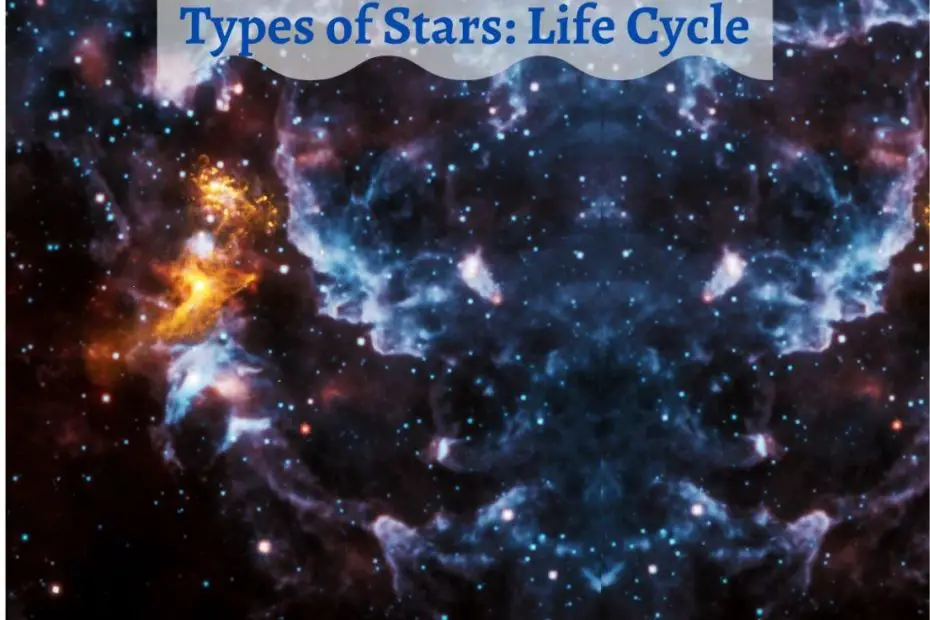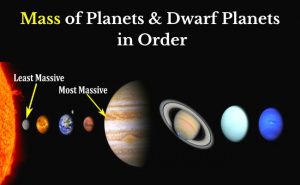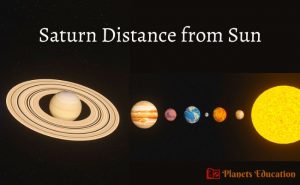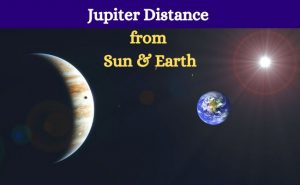When we look up at the sky at night, we only saw some smaller and bigger types of stars. You know a star takes birth, develops, and dies. A star has many phases throughout its life. Here, in this article, we will know about the life cycle of a star.
So, we only can differentiate these twinkling stars according to their size like bigger and smaller ones. And according to the color, they all look the same little reddish/yellowish color. Though astronomers have classified the stars while considering many factors like mass, temperature, and luminosity.
Here we are going to know in detail, what are the types of stars according to the life cycle!
According to the mass, there are mainly two types of stars. But when we consider the whole life cycle of stars, then these two are also subdivided into many categories. So in a life cycle of a particular star, it converts into many other phases of the stars which are also a type of star. Generally, the phases of the stars are called star types.
For example, a neutron star is one of the phases of a massive star and is also known as a type of star. A neutron star is converted after passing many life cycles by a massive star that has a mass of more than 8 times the sun but less than 40 times the mass of the sun.
According to spectrum and temperature, stars are also classified using English letters. Letters O, B, A, F, G, K, and M represent the different classifications of stars. These letters O, B, A, F, G, K, and M are in order of decreasing temperature and luminosity. O types of stars are the hottest and most luminous, whereas M types of stars are low luminous and coolest. This method of star classification is known as Morgan–Keenan (MK) system.
Life Cycle of a Star
Here, we have differentiated the stars according to their mass, rather than according to Morgan–Keenan (MK) method or temperature basis. Mainly there are two types of stars, Brown Dwarf which does not initiate nuclear fusion reaction of Hydrogen atom into Helium atoms, and Main-Sequence Stars which converts Hydrogen into Helium by means of fusion reaction. Further Main-sequence stars are classified into many categories according to their mass and life cycle.
- Brown dwarf stars (mass below 0.08 mass of the sun)
- Main sequence stars
- Low-mass stars (0.08 to 8.0 mass of the sun)
- Massive stars (bigger than 8.0 times the mass of the sun)
Here a picture is attached that gives a clear idea about the life cycle of a star and different types of stars and the life cycle of the star. (Must consider it> a star developed during its life cycle, is a type of star.)

⇒Brown dwarf stars
Brown dwarfs are the failed stars that never started nuclear fusion reactions in the cores, unlike other stars. These types of stars have a mass of less than 8% of the sun or 10 to 80 times of Jupiter. Due to the lack of enough mass and density, they are unable to create a nuclear fusion reaction of hydrogen atoms into helium atoms. However, they have a nuclear fusion reaction of Deuterium (H2) into the Helium3 (He3) nucleus.
A newly born brown dwarf produces a dim little heat but soon starts cooling and looks like a giant planet. Stars below 10 Mj (Mj-mass of Jupiter) are called sub-brown dwarfs and sometimes they are referred to as rogue planets.
- Read about:> Rogue Planets
⇒Main sequence stars
The main sequence stars create a nuclear fusion reaction of hydrogen atoms to helium atoms in its core and release extreme energy. Dwarf stars, red giant stars, and neutron stars all are an example of the life cycle of main-sequence stars. When all present hydrogen fused into helium atoms in the core of stars, then the star’s main-sequence life ends.
More than 90% of stars in the universe are main-sequence stars. It is divided into two main categories: 1. low mass stars, and 2. massive stars.
⇒Low mass stars
This category of stars has a mass of more than 0.08 to 8.0 times the sun. Our sun comes in the category of low-mass stars. The following mentioned stars belong to low mass stars and their life cycles.
Red dwarf:-
Red dwarf stars are the smallest type of main-sequence stars but bigger than brown dwarfs. These types of stars are most common in the milky way galaxy and are found in millions. The nearest star to our solar system Proxima Centauri is a kind of red dwarf star is located 4.2 light-years away from us.
These stars are the coolest type of star with a very low mass and luminosity. Even the largest red dwarfs have a luminosity of less than 10% of our sun. Generally, the mass of the red dwarfs is 0.08 to 0.6 times of the sun. The lifespan of a red dwarf depends upon its size and its mass, if it has a lower mass then the lifespan would be longer. Most of these stars have a life longer than the present age of the universe.
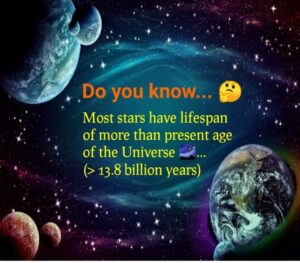
Yellow dwarf:-
These types of stars are bigger than a red dwarf and have a mass of 0.6 to 1.2 times of the sun. They convert the Hydrogen atoms into Helium atoms by nuclear fusion reaction in the core. The surface temperature of these stars ranges from 5000K to 6200K.
Our sun is a yellow dwarf star with a surface temperature of almost 5500K. These types of stars are also known as G-type main-sequence stars. Since the yellow dwarfs are not quite big in size, so the fusion reaction happens for approximately 10 billion years in its core.
Blue dwarf:-
This type of star is born when the red dwarf ends most of its nuclear fusion reaction. No blue dwarf has been found yet in the universe because our universe is not old enough to get exhausted by any red dwarf. Blue dwarfs are very low-mass stars and get converted into white dwarfs at the stage of their end of life.
Red giant:-
Red giant stars usually have a mass of 0.5 to 8.0 times the sun with a very big or moderate size. Sometimes, the mass of the red giants is as low as dwarf stars. The luminosity of these stars is really too high compared to the sun and may rise up to 3000 times the sun’s luminosity. The surface temperature of this type of star is approximately 5000K to 8800K.
When the main-sequence stars end the nuclear fusion reaction of hydrogen into helium, then the nucleus of the helium starts another fusion reaction and gets converted into the nucleus of carbon and oxygen. While happening this fusion process in the core the outer surface of the star starts getting expand many times compared to its previous size and becomes a red giant. The core temperature of a red giant star reaches approximately 108 K.
Planetary Nebula:-
The end of the red giant phase of a star creates a planetary nebula phase if its mass is around 1 to 8 solar masses. It forms when the Hydrogen atoms start diminishing in the core of a red giant star and the gravity in the core increases. Such a high rise of gravity in the core dramatically increases the temperature of the core up to 100 million K. The enormous temperature fuses the Helium atoms and converts it into Carbon and Oxygen. This fusion process in the core again stops the core contraction and grows carbon and oxygen. The high carbon-oxygen fusion reaction phase lasts about one million years and called the planetary nebula phase of stars evolution.
Due to high temperature, it emits ultraviolet photons and ionizes the outer atmosphere of the star. This ionized atmosphere glows and shines that’s why it is called a planetary nebula. The ionized outer surface of the planetary nebula reaches a temperature of approximately 30000K.
White dwarf:-
This is also known as a degenerate dwarf star because it gets developed by the core remnant of a medium-sized giant star. The density of the white dwarf is quite high as it’s a core remnant part. White dwarf stars get developed after almost all Helium fused into carbon and oxygen in the planetary nebula.
So the white dwarfs are made of the remnant core of carbon and oxygen. Sirius B is the closest known white dwarf star, almost 9 light-years away from us. These types of stars have very low volume like an earth size but the mass of these stars is very high like one solar mass.
Black dwarf:-
When the white dwarf stops emitting light energy, it is called a black dwarf. No black dwarf has been found in the universe, as it needs much more time to get developed compare to the age of the universe.
It is a late stage of a cooled remnant white dwarf. This type of star is a hypothetical star that does not exist in the observable universe. If a black star exists, it would be very difficult to detect, because the radiation it will emit would be very low.
Binary stars:-
Most of the stars in our universe have at least one companion and rotate around each other. The binary stars system are those stars that orbit each other with a common center of mass. When there are two stars then it is called binary star systems, if there are more than two stars that are orbiting each other then it is called multiple star systems. For example- stars ‘Alpha Centauri A’ and ‘Alpha Centauri B’ make a binary star system.
Wide binaries stars have a low impact on each other, while close binaries stars have a phenomenon of mass transfer. The distance and the transfer of mass through the companion stars results in a nova and type I supernova.
Type I supernova:-
Type I supernova is formed when a binary white dwarf system collapsed. For happening a type I supernova process one star in the binary system must be a white dwarf and the combined mass should be greater than 1.4 solar masses. Whereas, the second star in the binary system can be any type of star. Type I supernova are classified into type Ia, type Ib, type Ic according to their luminosity and spectrum lines. The supernova type Ia is most luminous and brighter than 5 billion times to the sun.
When the white dwarf of a binary system attracts the energy and hot gases of other companion stars, then the explosion results in a type I supernova. In this type of supernova, there is no hydrogen spectrum found as it is made of a white dwarf that already have finished the fusion reaction of all hydrogen atoms. While type II supernova always contains hydrogen spectrum lines.
⇒Massive stars
The stars that have a mass of more than 8.0 times the sun comes in the category of massive stars. Neutron stars and black holes are created after the collapsing of massive stars. The life cycle of massive stars is given below by explaining a short description of these types of stars.
Red supergiant:-
Red Supergiant stars are the largest stars in the universe according to their volume. But these types of stars do not fall in the category of most luminous or most massive stars. Red supergiant stars are cool in nature, even much cooler than our sun, but very large in size. Because of their big size, they are highly luminous. The luminosity of these stars may reach up to 50000 times of the sun and an interesting fact is that they are much cooler than our sun.
When the massive stars above 10 solar masses exhaust their main-sequence phase of hydrogen burning into helium. Then the helium core starts the fusion reaction if the core temperature reaches above 30000K. That’s how a red supergiant phase of the star gets born. At this high temperature, the core of supergiant stars produces elements like carbon, nitrogen, oxygen, neon, and other higher elements. This fusion reaction is continued happening in the core until the iron core is build up. Eventually, this iron core of the red supergiant stars collapses and develops into a supernova.
Type II supernova:-
Red supergiant stars convert all helium nuclei into heavier elements by the process of fusion. When these elements create an iron core then the supergiant stars collapse into a type II supernova.
For exploding into a type II supernova, the mass of the massive star must be in the range of 8 to 50 times of the sun. In this type of supernova spectrum, a large amount of hydrogen is ejected during the explosion process. Nuclear fusion reaction happens until hydrogen is converted into helium, and helium is converted into other heavier elements. When all the core is formed into iron and nickel elements, the fusion reaction gets stopped and the core contracts due to high gravity.
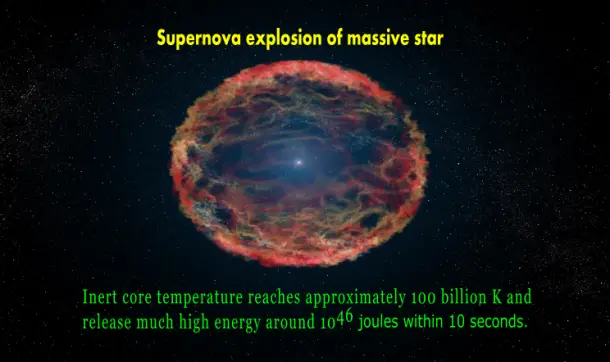
If the mass of the inert core is more than 1.4 times of the sun, an implosion occurs inside the core. In this process due to the implosion, the inert core temperature reaches approximately 100 billion K and release much high energy around 1046 joules within 10 seconds. That’s how a supernova explosion happens and it produces elements heavier than iron. Now the core forms a neutron star or black hole according to the mass.
Neutron star:-
If a massive star has a mass in the range of 8-40 times the sun, then it becomes a neutron star when a supernova explosion happens in the core. These types of stars are the smallest and have a size of around 20 km in diameter. The explosion of a type II supernova can create a neutron star or a stellar black hole.
A neutron star has a weight of around 1.4 solar masses. So here is an interesting fact about a neutron star:-
A 5 cm part of a neutron star is heavier than Earth:-
A neutron star gives amazing facts about the universe because of its heavier density and mass. So when we consider the weight of only 5 cm of neutron star then it would be approximately equal to the weight of our planet earth.
Let’s do some math-
20 km → 1.4 × mass of the sun
⇒ 20 km → 1.4 × 2 × 1030
⇒ 20 × 1000 × 100 cm → 1.4 × 2 × 1030
1 cm → 1.4 × 1024
5 cm → 7.0 × 1024
So, here we can see how it will be heavier than the mass of the earth (6 × 1024 kg)
Black hole:-
Here you find your favorite topic, isn’t it? I am not going to explain it in detail but you know “nothing can escape from a black hole”, so you too. A stellar black hole is formed when the massive stars have a primary mass of more than 40 solar masses. As no light can escape that’s why a black hole is invisible. With the help of some special instruments and the behavior of nearby stars, it can be detected.
(Read about– black hole facts and strange information)
Pulsar:-
A pulsar is a highly rotating neutron star that emits electromagnetic radiation in the form of beams from its magnetic poles. When we observe from the earth these stars radiate light in the form of pulses and that’s how they look like twinkling stars. As they radiate beams from magnetic poles and continue rotating very fast, they appear like flickering in the sky.
So, here were the different types of stars according to the life cycle in our Universe. I hope you have enjoyed reading about the life cycle of stars and their types.
Related:-
- 5 Best Solar System Backpacks in 2024
- Mass of Planets in Order from Lightest to Heaviest
- Star Projector {2024}: Star Night Light Projector
- Saturn Distance from Sun – How Far is Planet Saturn?
- Planet Books: Books about Planets (All Aged Kids)
- Jupiter Distance from Sun/Earth
